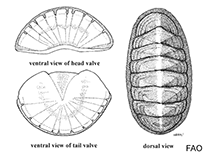Lepidozona cooperi (Dall, 1879)
Cooper's chiton| Native range | All suitable habitat | Point map | Year 2050 |

|
| This map was computer-generated and has not yet been reviewed. |
| Lepidozona cooperi AquaMaps Data sources: GBIF OBIS |
Upload your photos
Google image | No image available for this species;
drawing shows typical species in Ischnochitonidae.
Google image | No image available for this species;
drawing shows typical species in Ischnochitonidae.
Classification / Names Common names | Synonyms | CoL | ITIS | WoRMS
Polyplacophora | Chitonida | Ischnochitonidae
Environment: milieu / climate zone / depth range / distribution range Ecology
Benthic; depth range 0 - 20 m (Ref. 290). Subtropical
Distribution Countries | FAO areas | Ecosystems | Occurrences | Introductions
Eastern Pacific: Canada, USA and Mexico.
Length at first maturity / Size / Weight / Age
Maturity: Lm ? range ? - ? cm Max length : 4.4 cm TL male/unsexed; (Ref. 296)
Short description Morphology
Medium width girdle, with overlapping scales which are flat; larger at the valves and smaller at the margin of the girdle; deeply ridged with fine netlike sculpturing in between these ridges. Lateral areas: 5-8 rows of prominent beading. End valves: Radially beaded in ridges. Color of the valves: Olivaceous or gray; some have dark triangular blotches on the jugum. Girdle: Dark and light gray blotched (Ref. 296).
Depth based on occurrence record; to be replaced with better reference.
Life cycle and mating behavior Maturity | Reproduction | Spawning | Eggs | Fecundity | Larvae
Members of the class Polyplacophora are mostly gonochoric. Life cycle: Eggs hatch into lecitotrophic planktonic trocophore larvae (no veliger stage) which later metamorphose and settle on the bottom as young adults.
Main reference
References | Coordinator | Collaborators
Burghardt, G. and L. Burghardt. 2006. (Ref. 296)
IUCN Red List Status (Ref. 130435)
CITES status (Ref. 108899)
Not Evaluated
CMS (Ref. 116361)
Not Evaluated
Threat to humans
Human uses
| FishSource |
Tools
More information
Internet sources
BHL | BOLD Systems | CISTI | DiscoverLife | FAO(Publication : search) | Fishipedia | GenBank (genome, nucleotide) | GloBI | Gomexsi | Google Books | Google Scholar | Google | PubMed | Tree of Life | Wikipedia (Go, Search) | Zoological Record
Estimates based on models
Preferred temperature
(Ref. 115969): 10.4 - 18.2, mean 12.7 (based on 120 cells).
Price category
(Ref. 80766):
Unknown.



